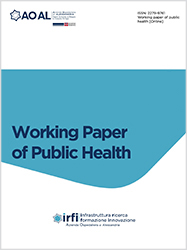Articoli originali
V. 11 (2023)
Analisi delle sottopopolazioni linfocitarie in pazienti affetti da COVID-19: uno studio osservazionale retrospettivo (LINFO-COVID)

Publisher's note
All claims expressed in this article are solely those of the authors and do not necessarily represent those of their affiliated organizations, or those of the publisher, the editors and the reviewers. Any product that may be evaluated in this article or claim that may be made by its manufacturer is not guaranteed or endorsed by the publisher.
All claims expressed in this article are solely those of the authors and do not necessarily represent those of their affiliated organizations, or those of the publisher, the editors and the reviewers. Any product that may be evaluated in this article or claim that may be made by its manufacturer is not guaranteed or endorsed by the publisher.
##plugins.generic.dates.received##: 7 dicembre 2022
##plugins.generic.dates.accepted##: 29 giugno 2023
##plugins.generic.dates.accepted##: 29 giugno 2023
1066
Visite
185
Downloads
Altri articoli dello/a stesso/a autore/rice
- Paola Toselli, Roberta Di Matteo, Cesare Bolla, Barbara Montanari, Marco Ricci, Elisabeth Marino, Serena Penpa, Tatiana Bolgeo, Antonio Maconi, Valutazione dell’appropriatezza delle misure di controllo relative alla trasmissione nosocomiale di microrganismi multiresistenti all’interno della SS Terapia Intensiva Polivalente: studio osservazionale , Working Paper of Public Health: V. 12 (2024)
- Roberta Di Matteo, Claudia Gota, Claudia Bina, Lorenzo Martino, Rossana Perciante, Giovanna Condino, Simona Arcidiacono, Menada Gardalini, Antonella Cassinari, Tatiana Bolgeo, Antonio Maconi, Valutazione dell’adeguatezza della preparazione intestinale nei pazienti sottoposti a colonscopia: uno studio retrospettivo , Working Paper of Public Health: V. 12 (2024)
- Alida Cotroneo, Federico Modeo, Carmelo Bennici, Roberta Di Matteo, Marinella Bertolotti, Tatiana Bolgeo, Antonio Maconi, INFORTUNI SUL LAVORO: analisi dei dati dell’Azienda Ospedaliera SS Antonio e Biagio e C. Arrigo , Working Paper of Public Health: Quaderni 2022
- Carlo Alboreo, Roberta Di Matteo, Gianluigi Piazzolla, Lucia Di Nardo, Giuseppe Dipaola, Enkeleda Gjini, Emanuele Tatò, Alessandro Scelzi, Antonio Maconi, Tatiana Bolgeo, Federico Ruta, Implementazione e impatto del Fast-track in un Pronto Soccorso: studio pre-post , Working Paper of Public Health: V. 12 (2024)
- Roberta Di Matteo, Menada Gardalini, Denise Gatti, Tatiana Bolgeo, Antonio Maconi, Un’indagine sulle competenze e la pratica degli infermieri riguardo alla somministrazione di farmaci mediante sondini enterali: studio trasversale , Working Paper of Public Health: V. 12 (2024)
- Carlotta Bertolina, Marinella Bertolotti, Antonella Cassinari, Riccardo Mazzucco, Carolina Pelazza, Marta Betti, Antonio Maconi, Valutazione prognostica delle mutazioni di KRAS e BRAF in relazione allo stato delle proteine del Mismatch Repair: analisi preliminare di sopravvivenza dei pazienti con adenocarcinoma colorettale , Working Paper of Public Health: V. 12 (2024)
- Giorgia Piceni, Gabriel Corbo, Carolina Pelazza, Serena Penpa, Marta Betti, Antonio Maconi, Data manager e coordinatori di ricerca: uno strumento per il monitoraggio dell’attività oraria , Working Paper of Public Health: V. 12 (2024)
- Elisabetta Scomparin, Roberta Di Matteo, Valentina Bigucci, Valentina Repetto, Haymanot Bonelli, Erika Berta, Tatiana Bolgeo, Antonio Maconi, Analisi del contesto prima epoca screening per SARS-CoV-2 RNA in tamponi rinofaringei, 2020-2022: comparazione tra due metodologie , Working Paper of Public Health: V. 12 (2024)
- Daniele D'Alessio, Rossella Sterpone, Antonio Pepoli, Antonio Maconi, Intervento strategico metacognitivo in una popolazione di anziani con declino cognitivo soggettivo , Working Paper of Public Health: V. 12 (2024)
- Alessia Francese, Andrea Di Stasio, Armando Serao, Roberta Di Matteo, Mariasilvia Como, Mariateresa Dacquino, Tatiana Bolgeo, Antonio Maconi, Un’indagine sui sintomi prostatici e qualità di vita nella popolazione maschile con patologie concomitanti afferenti all’Azienda Ospedaliera Universitaria di Alessandria , Working Paper of Public Health: V. 12 (2024)







